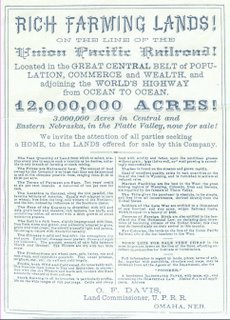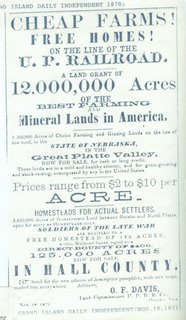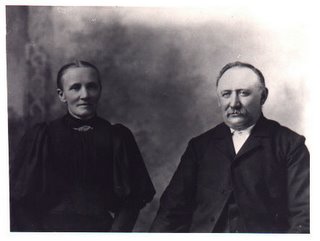The Reher Family History --
Germany To
America Johann Frederick Reher was born February 1st, 1840 in Bebensee, Segeberg province, Holstein, Germany. He was one of three known children born to Sophia Elizabeth Maria Ehlers and Hinrich Casper Reher. The other children known were Marcus Hinrich “Max” Reher, born January 14, 1834 and Hans Christian “Chris” Reher, born August 18, 1843. All three of these brothers immigrated to Hall County, Nebraska. Chris came with Johann in 1873 and Max came about 1884.
In 1863, Johann was untied in wedlock with Miss Sophia Vogt in Negennboetel, Segeberg province. Sophia was born June 12, 1842. That same year, 1863, Johann was called to serve in the 16th infantry regiment at Copenhagen. Leaving his new wife, he served until April, 1864. Then in 1867 he participated in maneuvers of the 25th regiment in Flensburg, Schleswig, Germany. Johann was again called to service in 1870 serving in the 85th regiment with the beginning of the Franco-Prussian War which ended with the Germans being victorious over Napoleon III. This time he left his wife and a young daughter, Emma, born in 1868. He was given a leave after some weeks but later served in the 75th regiment at Bremen and another time at Sonderburg, Schleswig.
Economic conditions were poor for nations as well as individual families. The continent was over-populated and there was extreme competition for its resources. The future was bleak and there seemed no relief in sight. Custom dictated that the oldest son inherited all his father’s property, so younger children often immigrated when they heard toe promises of free land. Having land to farm of their very own was a dream that brought many German immigrants to America. Another reason many young German men immigrated to America was to escape serving in Otto Von Bismarck’s armies. Europe was beset by extreme political unrest in the 19th century. National boundaries were frequently being changed. Individual religious practices depended on national religions. War was a way of life and conscription in the army was forced on young men.
Letters to the old country from early settlers gave glowing accounts of life and opportunity in the new land and urged family and friends to join them. The first group of settlers in Hall County arrived in 1857 with 32 Germans, most from the Schleswig-Holstein area of Germany, who had fled to America to escape Prussian militarism and had settled in Davenport, Iowa several years earlier. They sent word to relatives about the opportunities available here. An advertising campaign was launched on a grand scale, not only by the immigration offices of the State of Nebraska and local communities, but by the railroads who had land to entice the farmer and stockman from abroad. The Homestead Act of 1862 was a major attraction for European. It was the opportunity to own land and to be a citizen in a new country dedicated to personal freedoms. The Railroad Act made it possible for him to reach that new land easier.
(Above, to the right is an 1870s handbill... below is an add found in an 1870s Grand Island Daily Independent newspaper.)

Emigrants were advised to sell everything, because what they would need most was money. Without weeping, they must leave behind their home, the family treasures, the domestic animals, the machinery, and Grandma. Men were urged to take heavy clothes for work that didn’t show dirt, a suit, and plenty of warm clothing. Women were told to go with a minimum of clothing because the styles were so different in the new country that they would want to buy clothes when they arrived. Can we even imagine leaving all that is familiar, all of our possessions and family, our mothers and fathers, most likely never to see them again?
Two children were born to Johann & Sophia in Germany: Emma in 1868 and our grandfather, Ernest in 1872. Called to the service four or five times in less than 10 years and not knowing what the future would be, in 1873, Johann at 33 years old, decided to bring his family to America. They sailed from Hamburg, Germany on April 2, 1873 on the ship named Frisia; the captain was Captain Meier. Johann & Sophia had listed their hometown as Hagersdorf, Holstein, Germany. “Grampa” Ernest was listed as 9 months old. Also coming to America with Johann & Sophia was Johann’s brother Hans Christian Reher, age 30, and his wife Christine, age 22.
The trip from Hamburg to New York City took too weeks; they arrived April 16th. The typical cost of a trip would be about $30. The ship Frisia had accommodations for about 820 passengers. It was a 3,256 gross ton ship, length 349.5ft x beam 40.2ft, straight stem, one funnel, two masts (rigged for sail), iron construction, single screw and a speed of 13 knots. The Frisia was just one year old when the Rehers sailed. During 1873 the Frisia made 8 trips to America from Hamburg bringing 4,894 people to their new homes. There were 2 births and 6 deaths on the Frisia that year. 287,808 people immigrated to America during 1873, 37,890 leaving from Hamburg, Germany.
Once the Rehers arrived in America, there was still the trip from New York to Nebraska. By 1866, the railroad had been completed through Grand Island and they probably were able to take the train. The railroads made up immigrant trains to take people west. The cars were called zulu cars. Bunks without mattresses lined the sides with cooking facilities at the end. It took about five days to get from New York to Omaha, Nebraska. In Omaha, the new Nebraskans were put up in an immigrant house without charge for several days while they located their land, bought their supplies, and made plans for the biggest adventure of their life. According to the History of Hall County book, “the Rehers arrived in Grand Island on April 17th, just two days after the memorable snowstorm of that year.” Obviously one of the dates couldn’t be right as that would mean a one day trip from New York to Grand Island. But such is the case with local county history books of the times… lots of errors.
The Reher families came directly to Grand Island and settled down, arriving in America during what was called the “Panic of 1873” a nation-wide depression triggered by reckless speculation in railroad expansion. This was followed in the Cornhusker State, by drought and by grasshopper plagues in 1875 and 1876. The grasshoppers and droughts ruined the crops the first few years and convinced half of the people to pull out of Hall County. The Grand Island Times newspaper tells that there was a coal shortage in 1877, with exorbitant prices $2-$3 more in Grand Island than large metropolitan cities in the east. Later there were the terrible blizzards we’ve all heard so many stories about. Johann & Sophia must surely have wondered if they’d made the right decision in coming to America.
On February 18th, 1878, Johann Reher bought 120 acres from Henry Niehaus for $1100,00 located in section 36, township 11, range 9, in Washington township. Like many of our early German settlers, Johann & Sophia lived through the difficult times of early years, but persevered and even prospered. Adding to their family of Emma and Ernest, another daughter, Anna, was born after Johann & Sophia arrived in Hall County. Emma married Hans Scheel April 3, 1883. Then in a double wedding ceremony on October 6, 1893, when Ernest was 21 years old, he married Miss Helene Wilhelmina “Minnie” Stoltenberg and Minnie’s brother Ferdinand Stoltenberg married Amellia Heesch. The next year, on April 12, 1894, Minnie’s brother Carl Stoltenberg married Johann & Sophia’s other daughter, Anna. After their marriage Ernest & Minnie took over the family farm. Johann & Sophia left their homestead, only to have Sophia pass away in 1894.
In 1896, Johann Reher married Sophia Rohlf Schuller. (Below is a picture of Johann and Sophia Rohlf Reher... I have no pictures of Sophia Vogt, the first wife.) Sophia had immigrated to America from Germany at age 24 with her parents, Joachem and Anna Rohlf in 1873, coming on the same ship, at the same time as the Reher brothers. She married John D Schuller in Grand Island in 1873. Schuller had arrived in Hall County in 1862 and operated a Saloon on the corner of Front and Locust Streets, “about the first frame building in Grand Island” according to the Grand Island Daily Independent. Schuller also operated an early post office from his tiny cabin home. That cabin now serves as the post office in Stuhr Museum’s Railroad Town. The cabin wa built by placing bricks of dried clay between upright studs. The bricks, probably from clay taken from the warm slough, likely made excellent insulation. The bricks were covered over with plaster inside the cabin, and on the cabin’s exterior they were covered with siding. About 1890, Schuller built a new brick home for his wife and three children. John De Schuller died on August 12, 1895 at the age of 64.
Germany at age 24 with her parents, Joachem and Anna Rohlf in 1873, coming on the same ship, at the same time as the Reher brothers. She married John D Schuller in Grand Island in 1873. Schuller had arrived in Hall County in 1862 and operated a Saloon on the corner of Front and Locust Streets, “about the first frame building in Grand Island” according to the Grand Island Daily Independent. Schuller also operated an early post office from his tiny cabin home. That cabin now serves as the post office in Stuhr Museum’s Railroad Town. The cabin wa built by placing bricks of dried clay between upright studs. The bricks, probably from clay taken from the warm slough, likely made excellent insulation. The bricks were covered over with plaster inside the cabin, and on the cabin’s exterior they were covered with siding. About 1890, Schuller built a new brick home for his wife and three children. John De Schuller died on August 12, 1895 at the age of 64.
Johann & Sophia (Schuller) Reher lived on the old Schuller place (located just a block south of Bismark Road and just west of Stuhr Road in Grand Island). They both worked hard raising a garden with many vegetables that were sold in the city market from horse and buggy. On January 27, 1907, Sophia committed suicide by shooting herself through the head with a revolver. Some months earlier she had suffered a nervous breakdown and at that time, during a spell of melancholia, threatened to end her misery by taking her own life. Little, however, was thought of it. Johann kept the place and retired fro all work. On occasion he would take his horse and buggy and go visit his daughters Emma and Anna or son Ernest. When his health failed him, a small house was built on Emma’s place and some years later the house was moved to his homestead place, where his son Ernest lived.
On Oct 1, 1917, Johann sold the farm to Ernest for $10,000 and later Ernest bought 40 acres from Dietrick Schwieger to make it 160 acres total. Johann died on November 24, 1924 at the age of 84 years. About three months before his death, he became totally blind and unfortunately about ten days before his death, he missed his chair and fell, fracturing a hip. Johann was one of the oldest and most widely known on the island. He had been a resident for 51 years.
The summer after Ernest & Minnie were married and took over the operation of the family farm, they began their family of ten children. Their first child was a boy named Arthur John. Six boys were born approximately two years apart before Minnie was blessed with her own helpers in the form of three girls. These boys were Art, John, Hugo, Arnold, Emil, and Edward. The daughters were Ella, Frieda and Dora. The tenth and last child born was Bernhardt Ferdinand “Barney” born in 1912 and named after Minnie’s brother Ferdinand Stoltenberg and brother-in-law Bernhardt Wiese . The two oldest boys, Art and John moved to Wyoming after their marriages, buying farms near Pine Bluffs. The other 8 children married and raised their families in the Grand Island area. The sixth son, Edward, took over the family farm, buying it from Ernest in 1943 for $10,000, the same price Ernest paid his father, Johann, 26 years earlier. Eddy farmed the old home place until his death in 1977. His wife, Hedwig continued to live there until she had to move into town to a nursing home. Hedwig passed away at age 101 on January 6, 2005. The farm was sold at auction to Dan Cimino. At the present time he lives on South Blaine Street in Grand Island and doesn't plan on moving to the Reher farm. He owns horses which he will pasture there.
Minnie Stoltenberg Reher died August 21, 1939. Ernest Reher died June 20, 1945.
No footnotes... information gotten from my Aunt Frieda Buettner who didn't site her sources, from the Hall County History Book, obituaries, and newspaper articles... some paragraphs copied word for word.




1 comment:
I love that the first advertisement describes Nebraska as "the favorite latitude of America; free from the long cold winters of the Northern and hot, unhealthy influences of the Southern States." Uh, sure.
Post a Comment